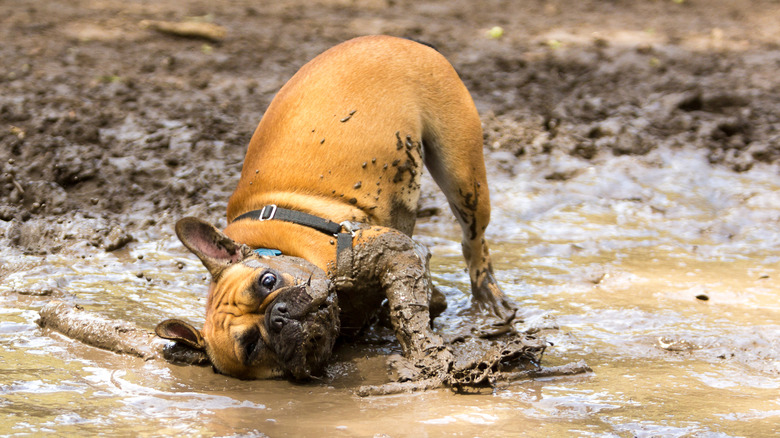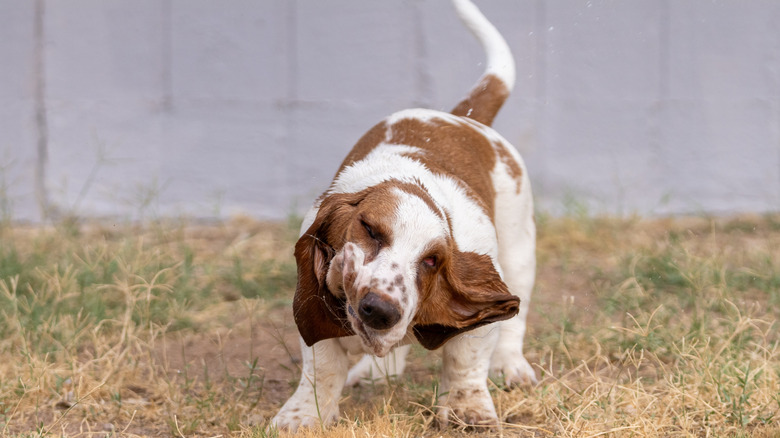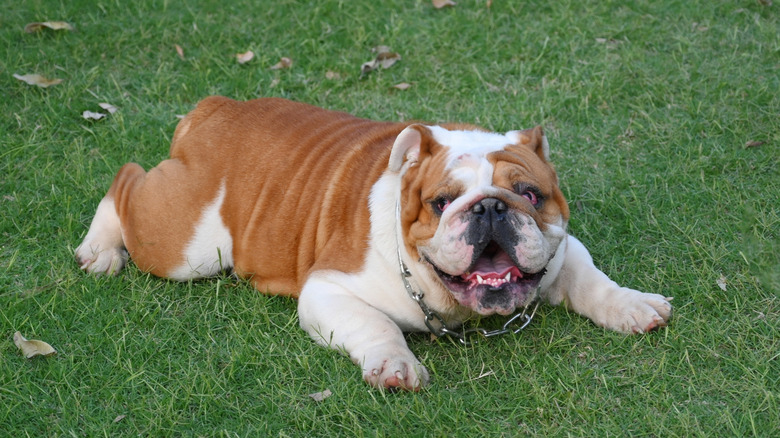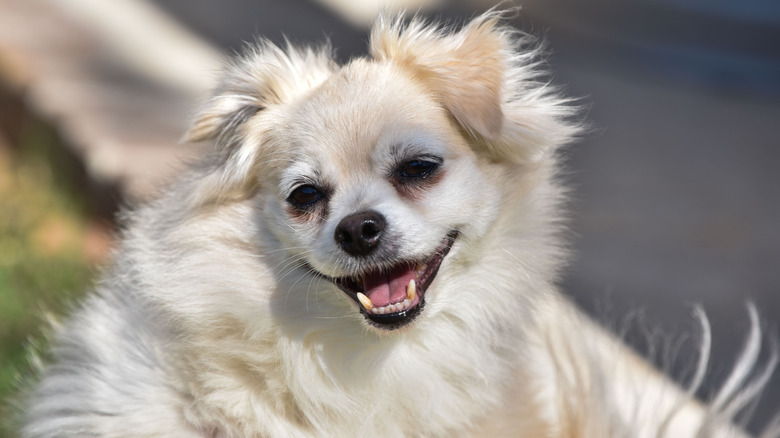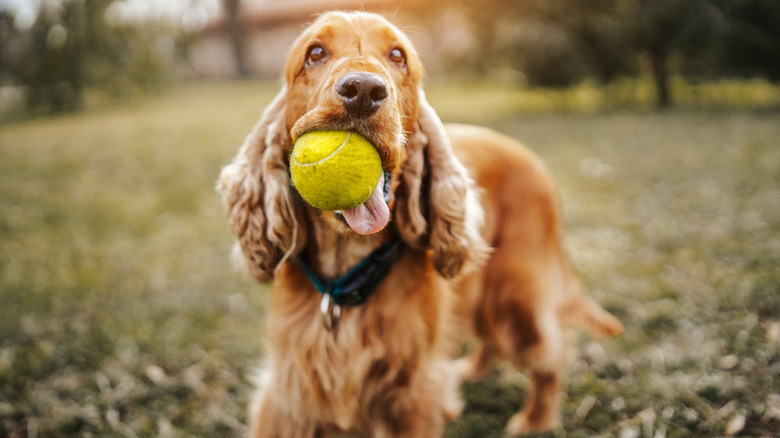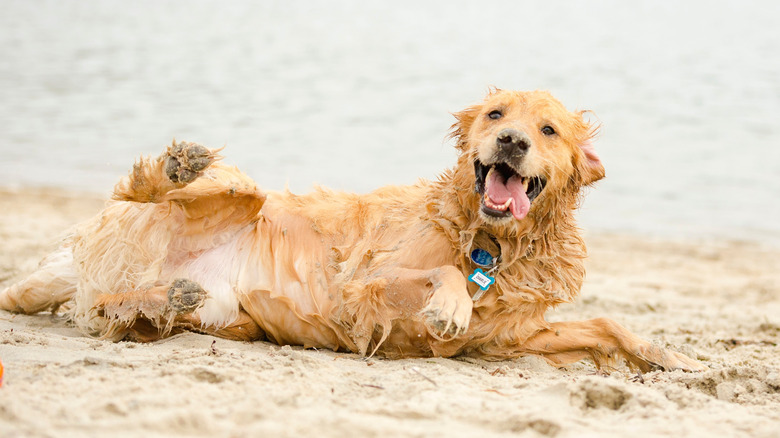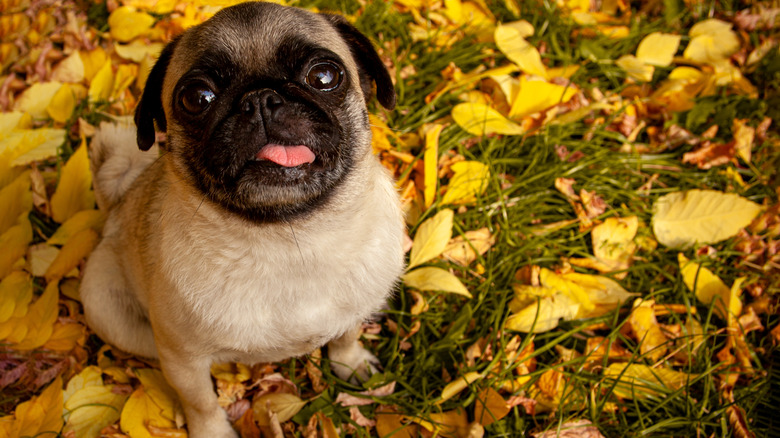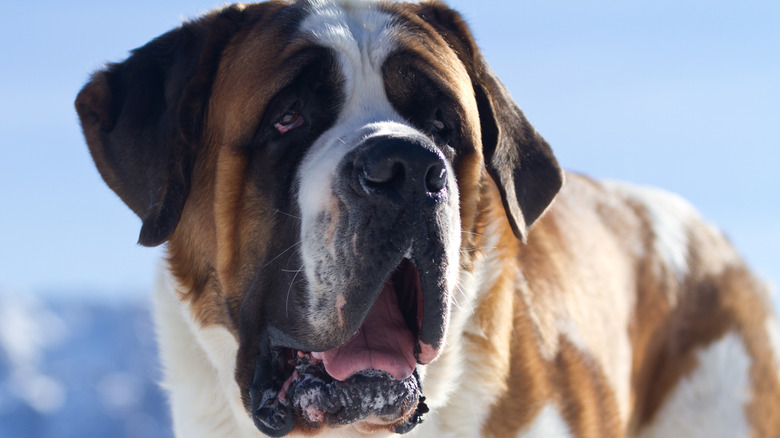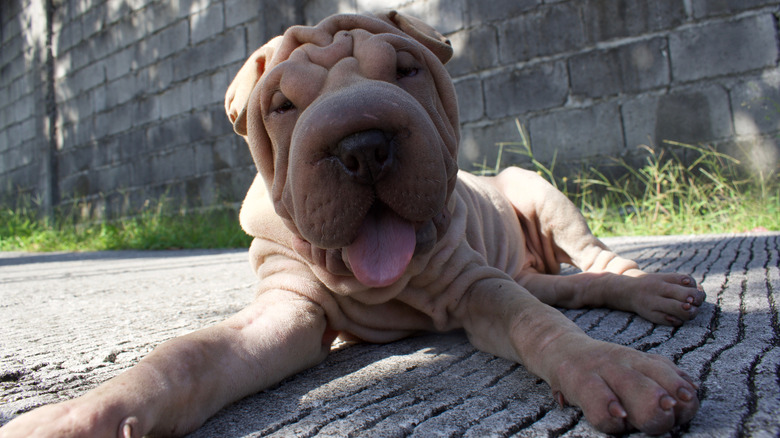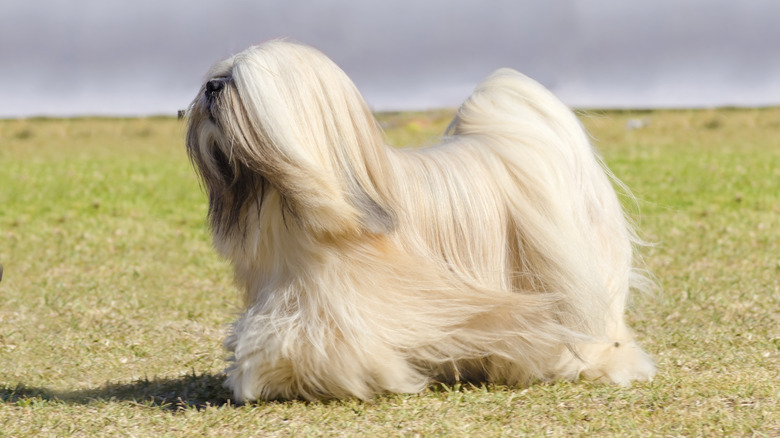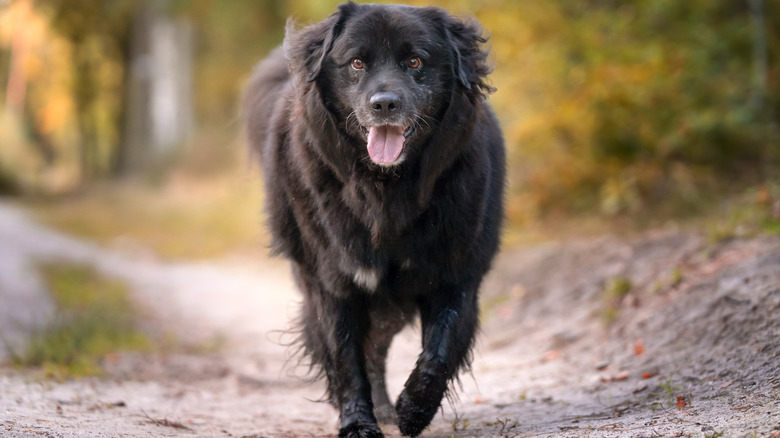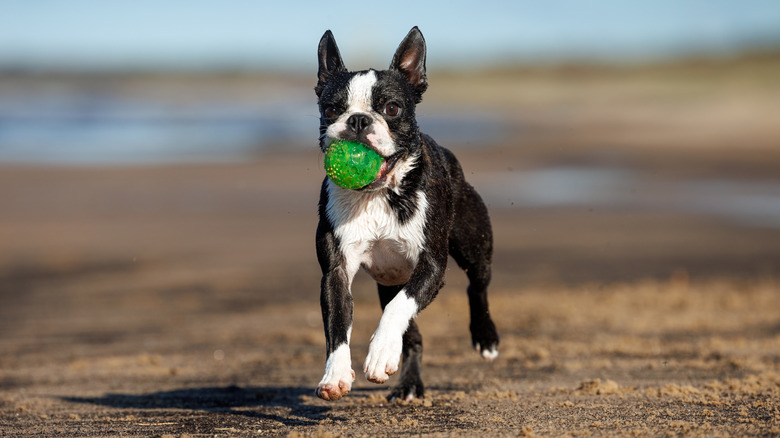The 12 Smelliest Dog Breeds (But We Love Them Anyway)
We may receive a commission on purchases made from links.
Many pet parents love nothing more than cuddling up next to their furry companions. However, the unpleasant odors that often come with dogs can make it difficult to maintain the physical affection they seek. Canines emit a variety of smells with different potential meanings, including the infamous "Frito Feet," but some stenches grow so overpowering that you can notice them from a distance.
Even the cleanest canine varieties can become rank without the proper care, while the most infamous stinkers can stay perfectly fresh and huggable with attentiveness towards their health. "Regular grooming, dental care and routine veterinary checkups are essential in maintaining a dog's overall well-being and minimizing odors," Dr. Kari Murdoch, DVM, shared with BeChewy. Of course, certain dog breeds are more prone to smelliness than others, whether because of known medical conditions or a high susceptibility to bacteria in their ears or skin folds. Thankfully, owners still find plenty of reasons to love them.
1. Basset hound
Basset hounds have an adorable look pet parents can't help but swoon over. Their long faces and ears have made their appearance iconic, with the breed inspiring the design behind Droopy Dog from MGM cartoons and "The Tom and Jerry Show." Yet, these little cuties can take on an odor because of these features, with skin fold and ear infections likely to occur without the right care routine. The breed also has a weather-resistant coat from its hunting days that can cause the active dogs to grow stinky when they work up a sweat and drool all over themselves.
A basset hound does not need to be a smelly boy or girl. Daily brushing will help keep its coat fresh; unless it has recurring skin infections, the breed does not require regular baths. Additionally, cleaning their eyes and ears with products like Veterinary Formula Clinical Care Ear Therapy and HICC PET Eyes Wipes on a frequent basis helps prevent infections and the build-up of mucus. However, you should consult a professional if you believe an infection has already developed.
Even when they smell, all basset hounds types make beloved companions. A relatively docile breed, these dogs need motivation to get going, but once they do, they overflow with personality and thrive at scent-related games. When properly socialized at a young age, the droopy-faced pups can get along great with other pets and children, making them ideal for a family living in an apartment, condo, or house.
2. Bulldog
A bulldog's many skin folds can trap bacteria, making them stinky and possibly resulting in skin fold dermatitis, which can come with an even more intense odor and cause pain and other issues for the canine. Meanwhile, their droopy jowls may produce excess drool with an odor. The breed also faces a challenge many new owners don't know to account for: the "tail pocket," a small indent underneath the tail that can get infected and carry some nasty odors.
Cleaning between the skin folds and targeted care for the tail pocket, including using products like Natural Dog Company Wrinkle Wipes, will help keep a bulldog itch and stench-free. "Skin fold dermatitis is a common problem in dogs with skin folds or pockets," shared Dr. Anke Hendricks in a 2022 study from the Royal Veterinary College. "Prevention or treatment of infection requires very frequent skin care or medication throughout a dog's life." Coat maintenance is also essential, with weekly or bi-monthly baths key. Make sure to dry the skin folds after bathing a bulldog to get rid of any moisture that can get trapped between them.
Bulldogs have a reputation for laziness, but when given the proper motivation and exercise, these curious pups love exploring the world alongside their caretakers. The bulldog also makes a great companion for families of any size and lifestyle. Just be prepared for their overly affectionate nature towards their favorites.
3. Chihuahua
The mighty Chihuahua can give off a surprising amount of odor for a dog with such a miniscule body. While considered one of the healthiest breeds, these pups often experience teeth issues, with dental disease more prevalent than in other canines. Such problems stem from tartar buildup, along with teeth overcrowding due to their smaller head sizes. Halitosis, a sharp, pungent smell emitted from a dog's mouth, can develop without the proper care.
Teeth overcrowding requires vet intervention, making regular check-ups essential for keeping your Chihuahua's mouth healthy. Pet parents can help prevent foul breath by regularly cleaning their dog's teeth. As daunting as it may seem, daily brushing is the best approach. A vet-recommended product like Virbac CET Enzymatic Toothpaste with a simple toothbrush can help prevent plaque build-up and the potential stench of halitosis.
Stinky breath won't stop a canine lover from appreciating the Chihuahua's adorableness. A bundle of energy one moment and a lap dog the next, you'll rarely encounter a dull moment with one of these tiny warriors around. Its small size also makes the Chihuahua a convenient travel companion.
4. Cocker spaniel
Cocker spaniels have a certain majestic quality that makes them popular show dogs, with their hair framing a wizened face with a long jaw and curly locks around their ears. Yet, they still can develop a host of potential smells. Their ears are prone to infection and need proper cleaning, and the breed also contends with a unique affliction, lip fold dermatitis, also known as "cocker mouth." The smelly condition results from a build-up of moisture and food in the beard and lower lip folds that breed bacteria.
While daily toothbrushing can go a long way, consider using products like SmileDenX's Dog Dental Care Wipes to help wipe down the gums. Remain mindful of the severity of any lip fold dermatitis; if a cocker spaniel experiences excess discomfort, drool, or stench, a vet may recommend cheiloplasty surgery. Finally, a good brush at least once a week will help keep those long, luscious locks of hair from attracting an odor.
A cocker spaniel can undoubtedly shine as a show dog, but the breed also makes a great pet. The adorable companion aims to please its owner, and training through positive reinforcement comes naturally. The laid-back temperament of the American or English cocker spaniel makes the doggo a wonderful roommate in an apartment or condo.
5. Golden retriever
The golden retriever's high intelligence and trainability have made it a familiar on-screen presence. Yet, star power doesn't necessarily keep away foul odor. The dog's double coat can prove challenging for inexperienced owners to maintain, with the multiple layers of weather-resistant and thick fur trapping all sorts of smells as the canine goes about its day. Irritants in pet hair can also lead to scratching, making the retriever susceptible to pyoderma, a bacterial skin infection that gives off a rank smell.
You can treat pyoderma at home, and the condition usually subsides in a couple of weeks without intervention; however, if it persists, you'll need to make a trip to the veterinarian. Bathing with products like Dr Teal's Unscented Epsom Salt and Veterinary Formula Itch Relief Medicated Shampoo can help soothe pyoderma symptoms. Golden retrievers shed a lot, so brushing every few days assists with controlling the mess, keeping their coats healthy, and allowing owners to look for signs of irritated skin.
Despite issues with its coat, the golden retriever makes an ideal family dog thanks to its natural kindness. The breed prides itself on getting a head pat and often bonds with other animals, kids, and strangers. Those who live an active lifestyle also tend to fall in love with their new energetic running buddy.
6. Pug
Pugs are one of the cutest small dog breeds in the world. However, despite their charms, these pups are notoriously stinky. While cleaning their skin folds will help prevent bacteria build-up and unwanted scents, you can't avoid one odor source: flatulence.
The flat faces of pugs may be endearing, but the feature places them among the brachycephalic breeds, which means they inhale primarily through their mouths. Such air intake can result in a gassy dog, a condition pet parents can't do much about. However, paying attention to what you feed it and promoting an active lifestyle can help to work out all those farts and lessen potential foulness. "Ensuring your dog has a balanced diet will be key in reducing any gastrointestinal (GI) issues," Dr. Whitney Miller, DVM, MBA, DACVPM, advised Rover. You can try a gradual transition to an easily-digestible food with more high-quality protein.
Regardless of the type of pug or pug mix, the breed is a bundle of joy, often happy and eager to please. The adorable little mouth-breathers love cuddling and splaying out on the couch but should still get moderate exercise. The breed is also famous, with Doug the Pug numbering among the wealthiest dogs ever.
7. Saint Bernard
As big doggos, Saint Bernards weigh between 120 and 180 pounds once fully grown. With such size can come a considerable stench, whether from rolling in something gross outside or their messy eating habits. Any pet parent with a Saint Bernard can tell you that when it comes to drinking water, you will get a drool trail following behind them. This excess of slobber stems in part from their working days when they used their saliva to help retrace their steps when performing rescues. However, it can create an unpleasant, smelly mess for a caretaker.
If excess salivation or other concerns arise around a messy mouth, speak with your vet to identify any underlying issues. Otherwise, a Saint Bernard owner must embrace the drool and can help control the scent by properly cleaning a mess and drying off their dog's mouth after play. These pups don't need regular baths, but you should brush their coats a couple times a week to keep them from matting and trapping odors, switching to daily brushing during the shedding season. Tools like Flying Pawfect's Dog Slicker Brush are essential for owning a Saint Bernard.
A true gentle giant, the Saint Bernard makes for a compassionate companion or a loyal worker. Drool need not be a deterrent for a pet parent, and some even embrace their slobbery nature. Online, you can find plenty of videos of owners showing off with pride how drooly their big boys and girls can be.
8. Great Dane
Looming tall amongst its peers, the great Dane can appear daunting with a standing height of over 3 feet. Despite its considerable size, the great Dane is not inherently stinky, with a coat that requires minimal maintenance and ears that, if kept clean, will likely remain free of bacterial infections. However, these majestic giants can clear a room quickly with the nasty gas common to the breed.
Inflammatory bowel disease can cause a stink in any dog breed; however, your great Dane might be gassy for other reasons. Deep-chested breeds tend to toot more often, but the diet and speed with which large doggo eats can exasperate an existing issue. Knowing how much and often to feed a great Dane is essential for curbing nasty flatulence. You can achieve better gut health for a great Dane by avoiding budget food and aiming for a low-fiber and lower-fat feed. Grabbing a slow-feed dog bowl can also help a quick eater slow down; pet parents can find one to match their pooch's style among LE TAUCI's offerings.
Great danes make great family dogs with the right training and early socialization. While they may seem intimidating, they belong to a kind and affectionate breed. They need space to stretch, and a couple of long walks a day are essential, but they are known to be chill and relaxed. This combination makes great Danes beloved companions for condo or apartment owners who want a large canine. However, they do best with access to a yard.
9. Shar-pei
With wrinkles on wrinkles and a large frame, few dogs are as instantly recognizable as the shar-pei. With all those folds come the required cleaning and maintenance to keep their coats fresh and avoid odors; they also tend to get a lot of ear conditions that necessitate diligent cleaning and maintenance to prevent bacteria build-up. However, even when kept clean, the shar-pei's unique combination of wrinkles and oily skin gives it a consistent, unique smell similar to chicken noodle soup that some consider unpleasant and others view as a lovable hallmark.
On top of its natural odor, infections like skin fold dermatitis or pododermatitis can result in an irritated and pungent coat. Red, black, or patches of missing hair can all point to issues with a shar-pei's coat — if the smell doesn't give them away. By regularly checking between their skin folds, you can spot problems earlier, with bathing essential every one to two weeks for the wrinklier dogs. To ensure the proper management of skin conditions, a shar-pei may need an antibacterial/antifungal shampoo like Veterinary Formula Clinical Care Antiseptic and Antifungal Medicated Shampoo.
The adorable wrinkles and expressive personality of the shar-pei are enough for most pet parents to overlook their potential smelliness. These canines are great for more experienced owners, as training and proper socialization are crucial for shar-peis. Yet, with the correct upbringing, the cutie make a good family pet or guard dog.
10. Lhasa apso
Has that mop just come to life, or is it a Lhasa apso? Lhasa apsos are dog show darlings, thanks in no small part to their long hair that sweeps the floor as they move. A pup this low down and hairy will pick up some smells wherever it goes. Yet, the breed faces other issues that can make it stinky, including a tendency to develop dental disease due to the dog's small size and ear infections. It is also prone to various skin conditions that can leave it itchy and foul smelling, including seborrhea, which causes flaky, oily, sore skin.
Brushing multiple times a week to prevent mats and baths once or twice a month will help keep a Lhasa apso's luscious mane fresh. Opting for a regular groomer and a teddy bear cut can also make maintenance of scents picked up easier at home. Cleaning its ears and brushing its teeth will further help keep unwanted odors from bacteria or yeast from building up.
While small, the Lhasa apso has 'big dog energy.' It thrives in a family environment and benefits from mentally stimulating activities. Watching the adorable little savants work through all the levels of a dog puzzle toy will make any pet parent forget about the challenges of removing the grit it may have picked up on a walk.
11. Newfoundland
Often lovingly referred to as Newfies, Newfoundlands can weigh between 100 and 150 pounds. While size does not always guarantee the accumulation of more smells, the breed's coat, which gives it its iconic look, attracts plenty of odors. As a double-coated dog breed, owners won't want to shave their Newfie; instead, they'll need to rely on consistent cleaning and grooming to keep it fresh.
Owners can bathe their Newfoundland every other week and should not put it off for more than four weeks. A big task, pet parents may want to schedule regular grooming to ensure the breed gets the proper bathing and drying. Beyond that, an omega-3 supplement can help maintain a healthier skin barrier underneath all that fur.
Despite the size and massive amount of hair that come with Newfies, they tend to win over their owners. Smart, hardworking, and affectionate, these are some of the sweetest canines anyone will have the pleasure to meet. The Newfoundland's big body matches its big heart.
12. Boston terrier
The Boston may have the most adorable look of all the types of terriers. Yet, with its flat face comes the expected problem of too much air intake, speed eating, or dietary issues working themselves out in the form of farts. The breed's oily skin also gives it a natural, slightly musky scent. Like most other dogs, the Boston terrier has a tendency to develop stinky feet caused by yeast buildup.
To prevent foul flatulence, the Boston terrier's diet should consist of food that uses rice as the carbohydrate, avoid soy proteins, and not exceed 30% dry matter protein content in food, per VCA Canada Animal Hospitals. The breed only needs light brushing to maintain its coat, and baths only when necessary. Yeasty feet seldom merit concern without the presence of other skin conditions. However, pet parents can proactively keep this smell curbed by regularly cleaning and drying its feet and maintaining its hair and nails; introducing a probiotic treat into a balanced diet can also help stop stinky paws.
A natural odor or Frito feet likely won't deter a caretaker from falling in love with a Boston terrier. They also have that terrier stubbornness, which many find a charming aspect of the breed. A clever canine known for bursts of energy, it makes for one entertaining companion.
